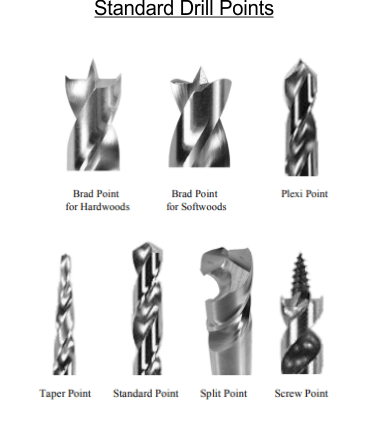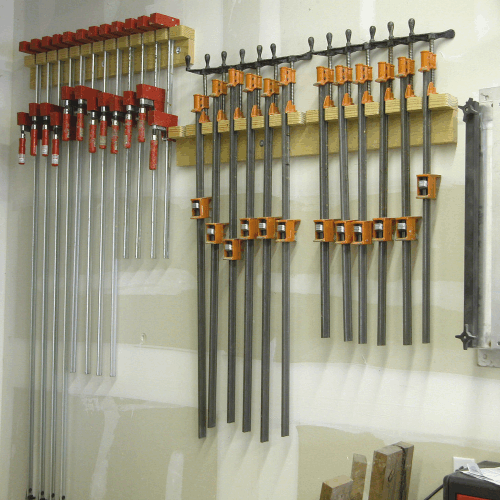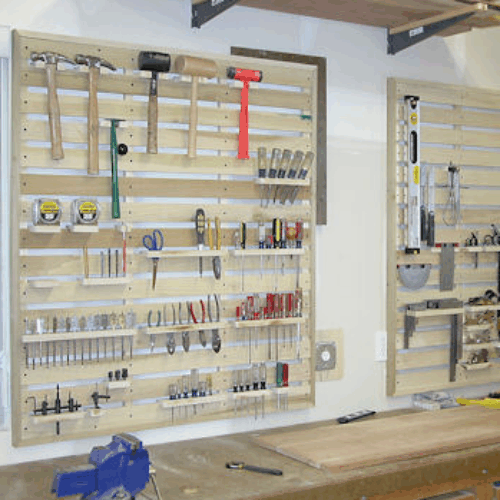Drill bits have various different point configurations with each configuration designed for specific uses. Each type of point design has its specific uses. There are 6 types of drill points:
Regular or Standard Point
Split Point or Four Facet Point
Brad Point
Plexi Point
Screw Point
Taper Point
Standard Industrial or Regular Point Drill Bits – Regular point drill bits or v-point drill bits have a 118 degree included angle point with cutting relief angles suited to cut metal. Drills with standard points specifically designed to cut wood usually have a longer point angle (i.e. 80 degrees). The longer 80 degree point can sometimes work better in wood if you are experiencing a problem with excess splintering on the backside when drilling through the wood. The 118-degree point is designed to be an all purpose point and will cut most all materials. If the standard drill point is not providing satisfactory results, one of the other types may be necessary.
Split Point Drill Bits– this type of bit usually has 135 degree included angle points and are designed to cut metal. Standard point drills have two cutting edges but there is a section in the center of the drill point called the chisel edge that does not actually cut, but chisels the material. The chisel edge can also cause the drill to walk across the material when you are trying to start the drill cutting on a particular spot. The Split Point drill has two additional edges ground into the chisel edge, which make the entire point of the drill one long cutting edge. This reduces the amount of pressure needed to make the drill cut. The Split Point is also self centering which means the drill starts cutting exactly where is comes into contact with the material. These characteristics were designed for drilling in metal but could be beneficial in some harder wood.
Why use brad-point drill bits? A brad-point drill bit should provide the cleanest, straightest, and most accurately sized hole in wood of any reasonably priced tool on the market today. The brad in the center of the point allows accurate positioning when starting a hole even if the hole is not 90 degrees from the surface. The outlining spurs sheer the wood grain and leave a clean edge around the opening of the hole eliminating the need for sanding. The spurs continue to sheer the wood while drilling and produce an accurately sized hole. In most woods, the spurs also help to produce a cleaner edge when drilling through the backside of the wood.
Our supplier, W. L. Fuller, Inc. has been manufacturing High Speed Steel Brad Point Drills for over 40 years. We have worked with thousands of customers to produce Brad Point Drills that satisfy their needs. We stock Brad Point Drills in every size including Wire Gauge, Letter Sizes, Metric Sizes and longer or shorter lengths. If there is a need for a size not covered by these, we can take a standard size and grind and/or cut it to a needed special size. We use industrial quality High Speed Steel domestic drills designed to cut metal and rework them to cut wood. The result is a Brad Point Drill made to metalworking tolerances with cutting edges that long outlasts standard woodworking tools.
There are basically two types of brad point designs we use. One works best in hardwoods and the other works best in softwoods. Brad Point Drills that are specifically designed for softwood produce too much heat and are hard to push in hardwoods. Although Brad Point Drills specifically designed to cut hardwood will cut softwood, the aggressive cutting edges have a tendency to lift the weak grains of the softwood resulting in a ragged edge around the opening of the hole. All of the Brad Point Drills we manufacture and show in our catalog are specifically designed for hard wood and work fine for most applications.

The difference between the two types of points is in the design of the outlining spurs. The Brad Point Drills that work best in softwood have rounded spurs, which help to hold the grains of the wood down while sheering them off. There is a certain amount of rubbing that occurs between the outlining spur and the wood before it is cut. The outlining spurs on Brad Point Drills for hardwood come to a sharp point and simply cut the stronger grains off clean. No rubbing occurs and therefore no unnecessary heat is produced by the cutting action.
If Brad Point Drills for softwood are needed, please specify “for softwood” on your order.
Another feature of the Brad Point Drill that could affect its cutting ability is the actual brad or pyramid point in the center. Although the sole purpose of the brad is to guide the drill through the material and keep it running straight, the shape of the brad can affect the results. The brad itself does not actually cut the wood. It mainly scrapes and pushes the wood aside. If the base of the brad is too thick or fat, the drill will be much harder to push especially in hardwoods. A brad that is too thin will allow the drill to cut freely but may break off in the process. It is also very important that the brad is exactly centered at the point of the drill. An off center brad can cause a drill to cut larger than it actually measures.
Often the length varies on the brad to achieve different results. A longer brad can be used when a hole needs to be drilled on an angle instead of straight into the wood. Drilling as much as 45 degrees or even 60 degrees from vertical is possible by extending the length of the brad. A shorter than normal brad may be required in the case of a hole that needs to be drilled close to but not through the back of the material.
Brad Point Drills also work well in most plastics, nylon, fiber, fiberglass and many other man made materials. If you have a question about Brad Point Drills, just call and ask us.
Plexi Point Drill Bits – Designed to cut plexiglas, the point can be between 60 degree and 80 degree included angle and the cutting angles are reduced to keep the drill from biting into the Plexiglas too fast. This point produces a clean hole and prevents the drill from breaking the Plexiglas when drilling through the backside.
Screw Point Drill Bits – Found strictly on wood cutting tool, these types of points are sometimes called Self Feeding points. Screw Points are designed to assist and control the rate of feed for that tool. In other words, the screw point controls how fast the tool cuts, and all but eliminates the need to push the tool. It is a must when drilling large holes with hand held equipment. The disadvantage of tools with screw points is, unless the screw point is replaceable, the tool will only last until the screw wears out. That may not take long in hardwoods.
Taper Point Drill Bits –this type point is designed specifically to predrill for the shank and threads of standard wood screws. Available in sizes and lengths to cover a wide variety of screws. Some customers have had success using this type of drill to cut through holes when a clean edge is required breaking through the backside. The taper point drill bit breaks through gradually and produces clean edges on both sides. Standard Drill Points Brad Point Brad Point Plexi Point Taper Point Standard Point Split Point Screw Point for Hardwoods for Softwoods






